Sri Lanka is one of the finest wildlife watching countries in South Asia. The island may be small in size, but the variety of habitats, and the wildlife found there, would do justice to a country many times its size. Even a visitor with only the most casual of interest can’t help but be overawed by the sight of great herds of elephants, enormous whales, elusive leopards, schools of dolphins, hundreds of colourful birds and reefs teeming with rainbow-coloured fish. The Sri Lankan tourism industry hasn’t been slow to cotton onto the country’s wildlife-watching potential and an impressive array of national parks, protected zones and safari options exist that allow anyone, from dedicated naturalist to interested lay person, to get out there with a pair of binoculars and make the most of the Sri Lankan wilderness.
Yala National Park
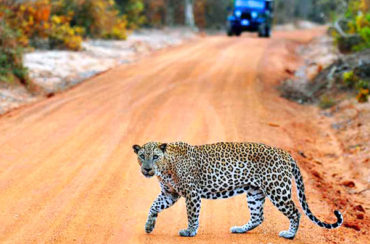
The park is situated in the dry semi-arid climatic region and rain is received mainly during the northeast monsoon. Yala hosts a variety of ecosystems ranging from moist monsoon forests to freshwater and marine wetlands. It is one of the 70 Important Bird Areas (IBAs) in Sri Lanka. Yala harbours 215 bird species including six endemic species of Sri Lanka. The number of mammals that has been recorded from the park is 44, and it has one of the highest leopard densities in the world.
The area around Yala has hosted several ancient civilizations. Two important pilgrim sites, Sithulpahuwa and Magul Vihara, are situated within the park. The 2004 Indian Ocean tsunami caused severe damage on the Yala National Park and 250 people died in its vicinity. The number of visitors has been on the rise since 2009 after the security situation in the park improved.
Udawalawe National Park
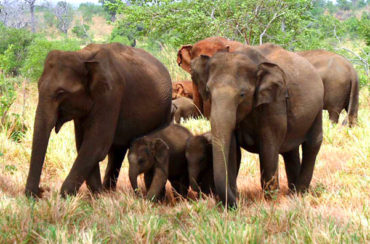
Udawalawe National Park lies on the boundary of Sabaragamuwa and Uva Provinces, in Sri Lanka. The national park was created to provide a sanctuary for wild animals displaced by the construction of the Udawalawe Reservoir on the Walawe River, as well as to protect the catchment of the reservoir. The reserve covers 30,821 hectares (119.00 sq mi) of land area and was established on 30 June 1972.Before the designation of the national park, the area was used for shifting cultivation (Chena farming). The farmers were gradually removed once the national park was declared. The park is 165 kilometres (103 mi) from Colombo. Udawalawe is an important habitat for water birds and Sri Lankan elephants. It is a popular tourist destination and the third most visited park in the country.
Udawalawe is an important habitat for Sri Lankan elephants, which are relatively easy to see in its open habitats. Many elephants are attracted to the park because of the Udawalawe reservoir,with a herd of about 250 believed to be permanently resident. The Udawalawe Elephant Transit Home was established in 1995 for the purpose of looking after abandoned elephant calves within the park. A total of nine calves, on two occasions in 1998 and 2000, with another eight calves in 2002, were released in the park when old enough to fend for themselves.
Bundala National Park
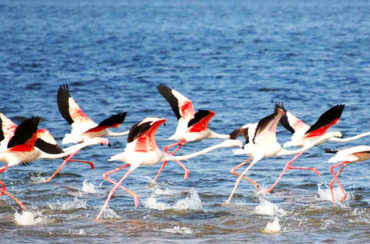
Bundala National Park is an internationally important wintering ground for migratory water birds in Sri Lanka. Bundala harbors 197 species of birds, the highlight being the greater flamingo, which migrate in large flocks. In 1991 Bundala became the first wetland to be declared as a Ramsar site in Sri Lanka. In 2005 the national park was designated as a biosphere reserve by UNESCO, the fourth biosphere reserve in Sri Lanka.
Covering an area of slightly more than 6,200 hectares, the Bundala National Park is located in the southern district of Hambantota, 245 kilometres (152 mi) southeast of Colombo. It falls within the dry zone and its climate can be described as hot and arid. The vegetation is predominantly of a dry thorny scrubland variety which provides a natural barrier to the wind and the terrain is flat with sand dunes that border the coastline. The Park features a series of lagoons which are an important habitat for wintering water birds. The best time to visit the Bundala National Park is between August and April when shore bird numbers can reach as high as 20,000.
Minneriya National Park
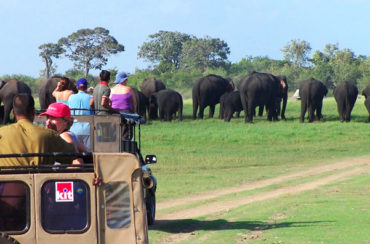
Minneriya National Park is a national park in North Central Province of Sri Lanka. The park is a dry season feeding ground for the elephant population dwelling in forests of Matale, Polonnatuwa and Trincomalee districts. Along with Kaudulla and Girithale, Minneriya forms one of the 70 Important Bird Areas (IBAs) of Sri Lanka. The park is situated 182 kilometers (113 mi) from Colombo at Habarana – Polonnaruwa road.
This national park is one of the best places in the country to see wild elephants, which are often present in huge numbers, and wading birds. Dominated by the ancient Minneriya Tank, the park has plenty of scrub, forest and wetlands in its 88.9 sq km to also provide shelter for toque macaques, sambar deer, buffalo, crocodiles and leopards. The national park’s faunal species include 24 species of mammals, 160 species of birds, 9 species of amphibians, 25 species of reptiles, 26 species of fish, and 75 species of butterflies.
Large numbers of Sri Lankan elephants are attracted to grass fields on the edges of the reservoir during the dry season from May to September. The Minneriya tank contributes to sustain a large herd of elephants. Individuals of elephants gathered here is numbering around 150-200.Some reports account number of elephants to as high as 700.[5] They migrate here from Wasgamuwa National Park and benefited from food and shelter of the park’s forest. Tourists visit Minneriya largely because of elephants, especially in dry season.
Pinnawela Elephant Orphanage
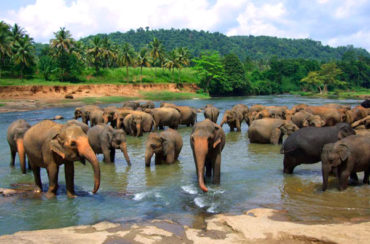
Pinnawala Elephant Orphanage is an orphanage, nursery and captive breeding ground for wild Asian elephantslocated at Pinnawala village, 13 km (8.1 mi) northeast of Kegalle town in Sabaragamuwa Province of Sri Lanka. Pinnawala is notable for having the largest herd of captive elephants in the world. In 2011, there were 88 elephants, including 37 males and 51 females from 3 generations, living in Pinnawala.
Pinnawala is the most popular and accessible place to see large numbers of these lovable animals in a natural habitat. It is the most popular elephant ‘attraction’ with tourists because nowhere else, except at the splendid ‘pereheras’ will you see so many elephants at such close quarters. The government opened it in 1975 since many more baby elephants than usual had become separated from their herds that year. The persistent drought had dried up many village wells into which the young elephants had fallen, while attempting to get a drink. Even today elephants fall into quarry or gem-mining pits, and poachers or angry farmers who shoot the adults for destroying their crops, orphan some youngsters.
The Orphanage is open from 8.30am to 5.45pm and visitors can interact a little with the elephants during the regulated bathing and feeding times. The baby elephants gulp down several huge bottles of milk, fed to them by their mahouts, and then it’s off to the river for a bath. The inherent gentleness of the animals is most obvious during this time. Most of the elephants eventually become ‘working’ elephants, and some older females occasionally add a baby to the herd.
